Plants are an instrumental key strategy to maintaining cleaner air, including their removing air borne toxins, in your tiny home. Living in a tiny house has many benefits, one of which is the lower utility bills. This often means cleaner air inside the house, free from some of the common air pollution large HVAC unit might produce. Generally this is often a result of using passive housing solutions, as well as alternative methods to heat (or cool) our tiny houses. Further, often overlooked is the heroic (dare I say “epic”) benefits plants provide!
Table of Contents
- Some of the Pollutants Removed by Plants
- How to Choose “the” Plants
- Some Common Indoor Air Pollution Sources
- What Others are Saying…
- Listing of My 5 Epic Air Purifying Plants
- Other Tiny House Plants…Just for fun!
Tiny Houses are becoming more and more popular. They are environmentally friendly, and again… low-cost to live in, and there is a lot of space to decorate them – When properly planned. Plants can fill some areas you want to hide, or bring to life.
The problem is some tiny houses can be quite stuffy because of the lack of extra natural light (that I’ve seen in some) and air circulation (for that matter, there are several larger houses I’ve been in that experience the same challenge). That’s why it is important to have plants in our tiny houses as they help with air purification. This does not mean plants will clean all the air of contaminants, rather they help (not only with air quality, but also with mental health).
Some of the Pollutants Removed by Plants
Some plants filter the air by removing volatile organic compounds, such as benzene, formaldehyde, xylene and trichloroethylene. Others absorb ozone gas from the atmosphere, which reduces lung irritation as well as irritation to eyes and throat caused by excessive exposure to ozone gas or smog.
With any plant, it’s important to remember that it might be toxic to pets and people, so it’s important consider the plants you select, and also to be aware of how your family and pets interact with them.
The typical house has toxins in paint, carpets, furniture, household cleaners and more. All of these items produce chemical emissions that are harmful to our health. Air pollution can lead to cardiovascular problems, respiratory problems, lung cancer and many more serious medical conditions. I have listed 5 plants which can help clean the air inside your tiny house, on an astounding level.
How to Choose “the” Plants
Much of my consideration (in addition to cleaning the air) was also the viability of the plant. By that I mean…
- Can cuttings be made (to downsize the plant when it’s to big) or the ease of re-potting
- The shape, some tiny houses often do better with slender plants (rather than big bushy “trees”)
- How well (and fast) the plants can help to improve my indoor air quality
- Light levels the plants needs to flourish
- Maintenance (I love plants, but don’t want to spend all day working on their care)
Some Common Indoor Air Pollution Sources
Before listing the plants, it’s important to be aware of the sources of indoor air pollution. This way we can attempt to help by mitigating, or at least reducing some of the most common (shortlist) causes:
- Paint
- Carpeting
- Upholstery
- Cleaning products
- Furniture
- Building materials
- Outside pollution being drawn indoors
I’m particularly referring to VOC’s (Volatile Organic Compound’s) and the need to eliminate them. While I’m sure many of us have seen the NASA studies about the best plants, etc. The problem is, in reality, with larger homes, we would need to have hundreds of plants to truly make significant reductions in pollution levels. Understandably for most, I don’t think that is a realistic option.
This is where a tiny house has an added benefit, it’s a smaller space, so the plants we choose can have a more powerful effect (as there is less air volume to “clean”).
A more realistic and practical approach is to ensure we not only select plants with the best air purification potentials, but also to leverage other benefits. Such as stress reduction…
What Others are Saying…
This is an important issue not only here in Canada, but elsewhere. In Canada, for example, the “Health Impacts of Air Pollution in Canada: Estimates of morbidity and premature mortality outcomes” report (2021) was published, and suggested that:
“…Health Canada estimates that above-background air pollution, including air pollution from human sources in North America, contributes to 15,300 premature deaths per year in Canada…”
and
“…exposure to air pollutants in indoor environments was not considered…”
which (to me at least) suggests the actual deaths caused by air pollution might be higher when considering indoor air quality?
What’s more another StatCan insight (2020) “Housing characteristics and staying at home during the COVID-19 pandemic” advised:
“…90% of respondents reported they were avoiding leaving their home as part of their COVID-19 response…”
While the above statistics and studies might illuminate the subject, and perhaps lay more emphasis on using natural methods (such as plants) to help reduce indoor air pollution, it seems some of the study reports can be debated endlessly – Which is not the crux of this post.
I have tracked down five plants that can help you to clean the air in your tiny house without taking up too much space! These are plants I currently grow, and truly enjoy.
Listing of My 5 Epic Air Purifying Plants
Pothos Ivy (Epipremnum aureum)
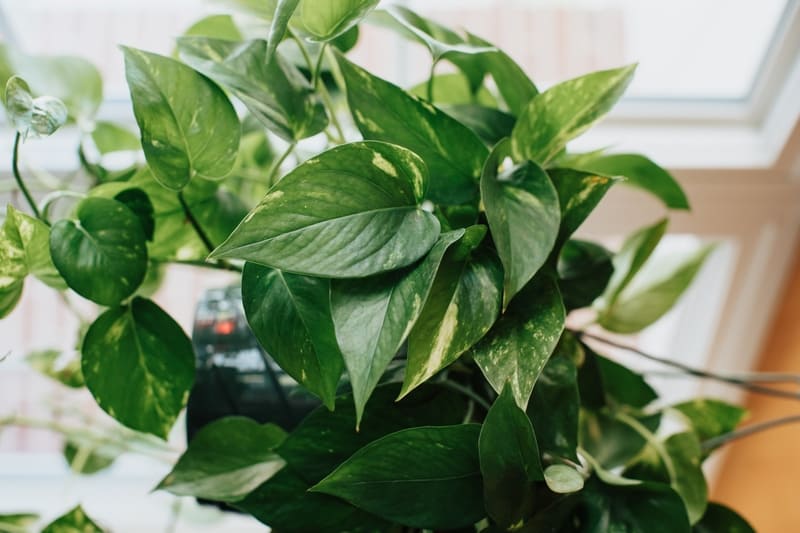
This plant was genetically modified to enhance it’s ability to help remove indoor air pollutants; it also has some florescent colouring. (The CBC ran a story about this in 2019: A genetically modified houseplant could suck up dangerous indoor air pollution).
The unmodified version is easy to find, which I grow. Removes CO2, benzene, chloroform, formaldehyde, toluene, xylene .
Why I suggest Pothos plants:
- Grows in low light conditions
- Requires minimal maintenance
- Easy to take cuttings and re-pot
- Easy to grow
- Can be used in a pot of trailers in a hanging basket
- Good at removing chloroform and benzene
- Even grows in a jar of water
Snake Plant (Dracaena trifasciata)
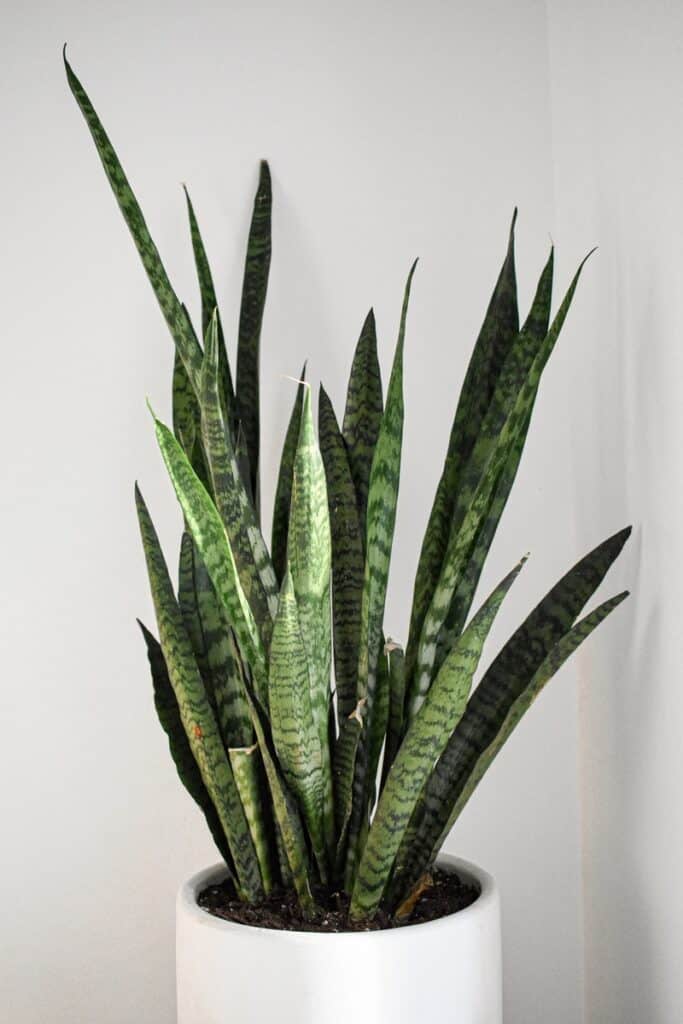
These plants absorb pollutants, such as: CO2, benzene, formaldehyde, trichloroethylene, toluene, and xylene. Some of the pollutants contribute to causing cancer. This is an easy to obtain plant.
It is particularly good for a bedroom (air quality), and when it eventually flowers (they flower at night), the fragrance is extremely relaxing.
It needs very little care, and is even easier to separate or re-pot (whenever needed).
Why I suggest Snake plants:
- They grow in a lot of light conditions (and do very well in a north window)
- They get flowers that smell great
- The are good for sleeping because they provide oxygen at night (cleans air day and night)
- Low maintenance, does not need a lot of watering
- Easy to split and re-pot
- It grows upright in long leaves, so does not waste space
- Easy to grow
Spider Plant (Chlorophytum comosum)

These plants help clean up CO2, toluene, ammonia, formaldehyde, nitrogen dioxide. They are very easy to obtain.
Super easy to grow, both from baby shoots and from seeds. They grow quickly!
Why I suggest Spider plants:
- They grow well near a bright window
- Easy to grow the shoots as a new plant
- Slender leaves don’t use too much space
- Easy to take care of
- If the plant gets too big, give it away and start a new one
- The plant grows quickly
Pineapple Plant (Ananas comosus)
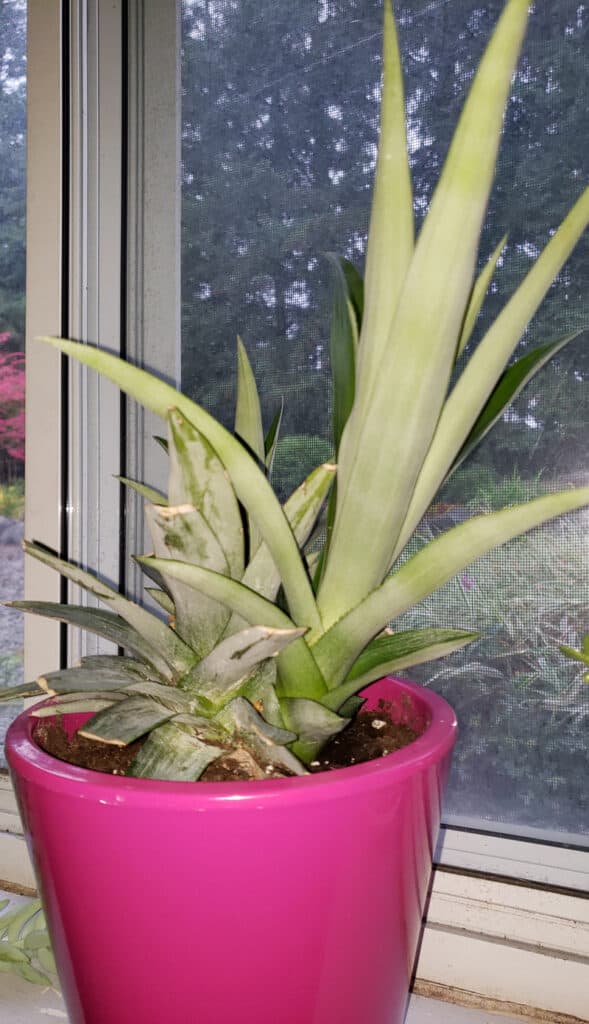
These plants help remove CO2, benzene, formaldehyde, toluene.
Easy to grow and obtain. For some… Be careful as the leaves are spiked, and have sharp teeth along some edges.
In the beginning is does not look too nice (like the photo here). But over time, nice shoots grow (there is a shorter shoot growing behind the bigger shoot.
I found this plant does well in windows, and in the summer can take full sunlight!
Why I suggest Pineapple plants:
- They produce oxygen at night (good for sleeping) – It cleans air at night and in the day
- Grows nicely in a full sun window
- Low maintenance and slow growing
- Easy to care for, neglect tolerant
Red-Edged Dracaena (Dracaena marginata)
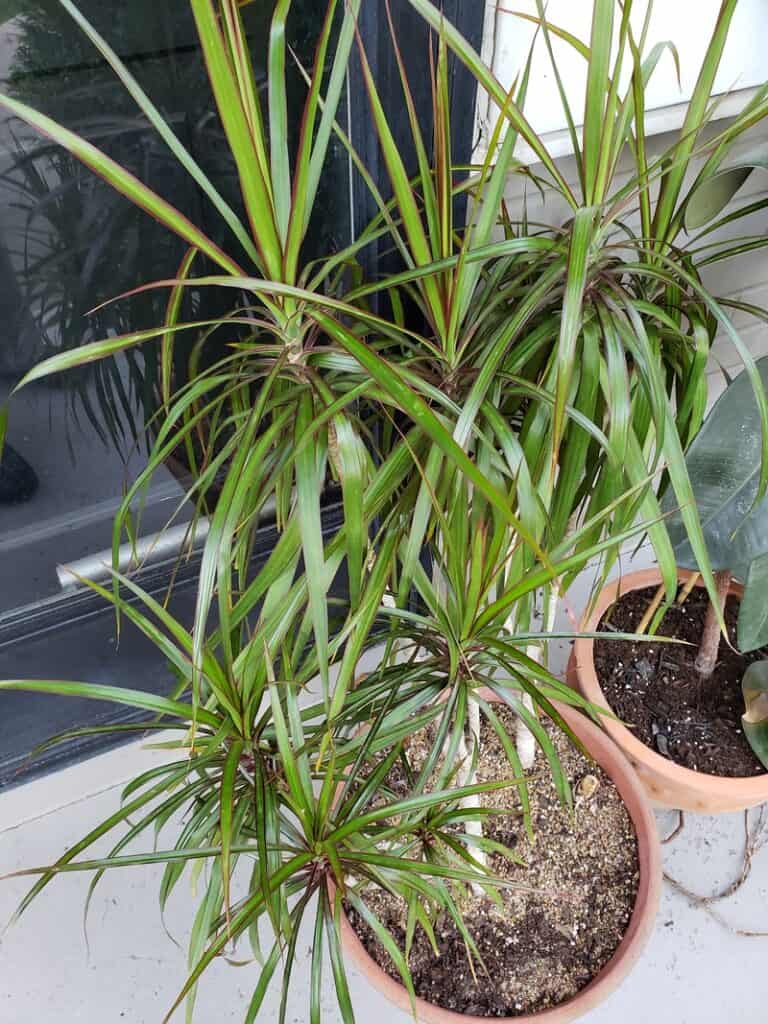
Helps remove CO2, benzene, formaldehyde, trichloroethylene, toluene. Easy to grow but… They are sensitive to salts and other chemicals found in most tap water.
While they are sensitive to elements in most tap water, I’ve found they are fairly easy to care for, and very forgiving if you place them outside in the summer for some morning sun (but not any direct sun).
Why I suggest Dracaena plants:
- A thin upright plant that won’t take up a lot of space
- Can be pruned down in size easily
- They grow slowly
- Can be used in a bright (filtered) light area, but can tolerate low light
- Can be placed outside in the summer
Other Tiny House Plants…
Just for fun!
Two other plants that I personally like, and fit in well with tiny (or smaller) homes the Elephant’s Foot and ZZ Plant .
Elephant’s Foot
(Beaucarnea recurvata)
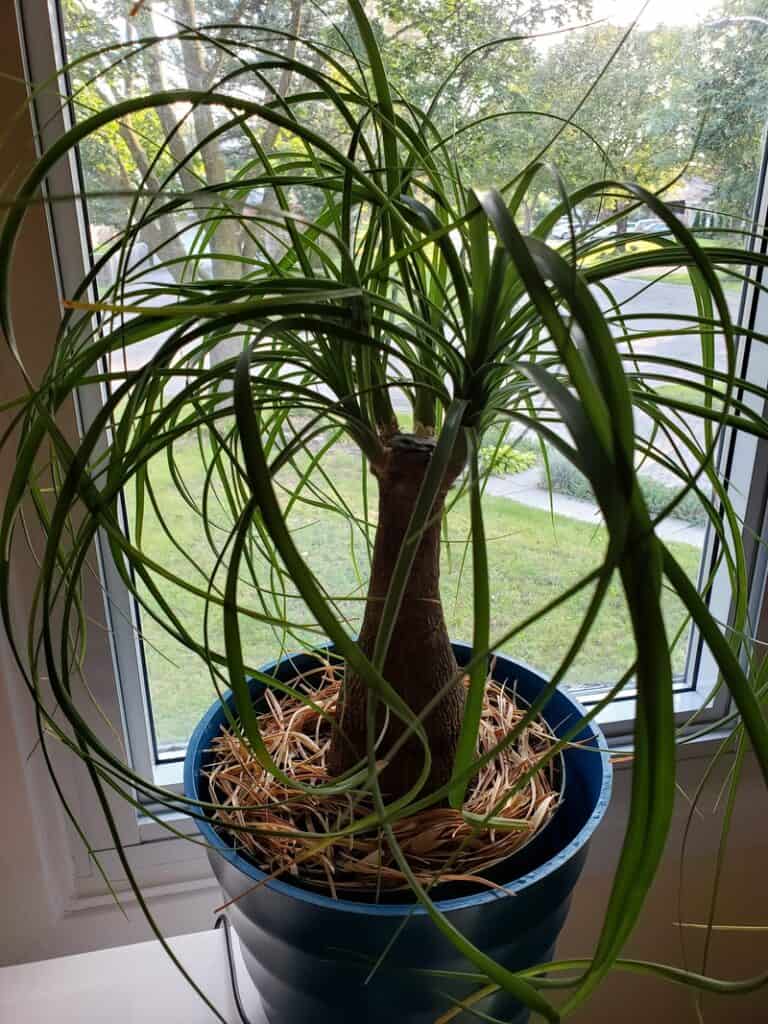
This plant is an interesting one, with a lot of character – In particular the thick rounded, bulbous trunk. It’s very easy to grow and I keep it in brighter light during the summer, and lower in the winter.
It hardly needs watering (because the trunk stores water). Grows very slowly (mine is five years old and is only about 20cm in height).
ZZ Plant
(Zamioculcas zamiifolia)
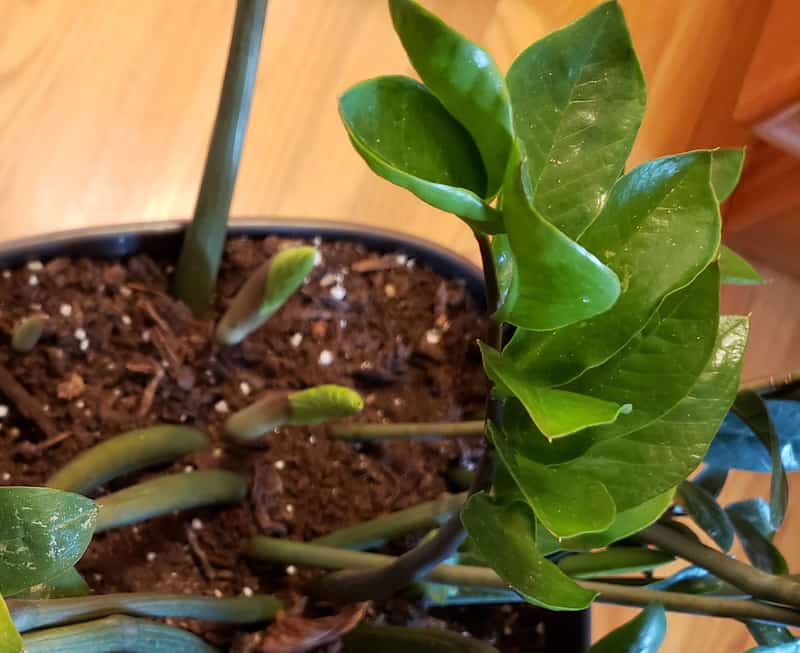
This is a vibrant happy plant, with thick evenly spaced leaves. Super easy to care for (even when neglected).
I hardly water the plant and do prune it back at times. While it does grow slowly, and tolerates low light, it’s still easy to create cuttings.
Can be placed anywhere!
To get an extra growth boost, place the plant outside in the summer, but never in full sunlight. I find it seems to to best with morning sun and a shady area.
Hopefully this introductory post about using plants to help clean the air in your tiny home, raises some good points for your research and follow up (there are lots of other plants you can consider and use). If you have any questions, suggestions, etc., please feel free to include them in the comments below (or you can even choose to be a guest writer).

I should add, one good resource for a list of air filtering plants is here: https://en.wikipedia.org/wiki/NASA_Clean_Air_Study
Also… An interesting read here, highlighting the benefits: https://www.bbc.co.uk/programmes/articles/1t7YdJHhCh7NRqQcf87zlP6/could-getting-some-houseplants-improve-your-health